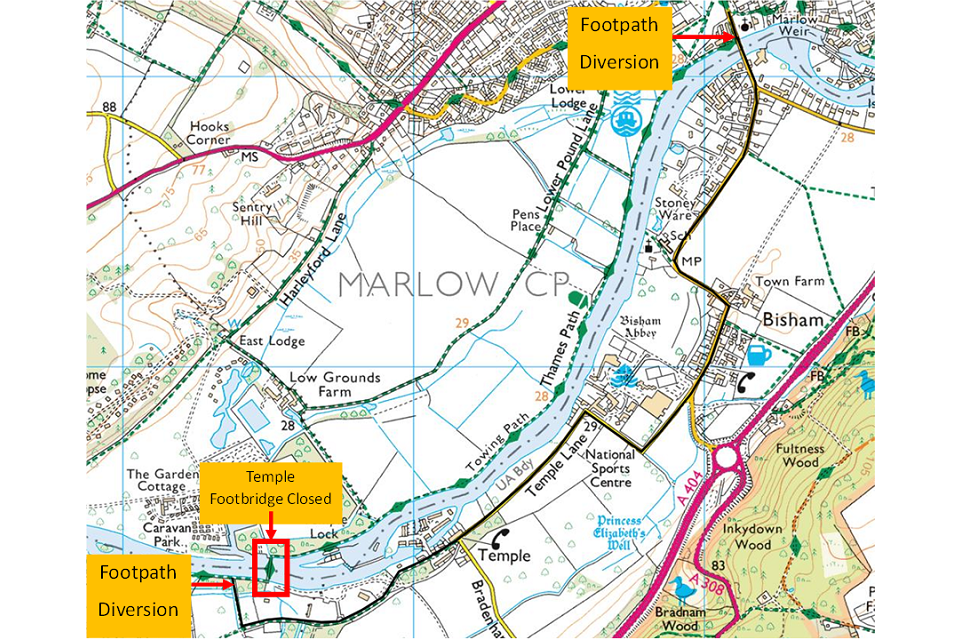Temple Footbridge to remain closed
On 15 May 2023, the Environment Agency closed Temple Footbridge until further notice due to safety concerns. Since then, the Environment Agency have been assessing what work is required to make the bridge safe. The first part of that assessment is now complete.
History of the bridge
Temple Footbridge was opened in 1989 with an estimated design life of 30 years. Funding for its construction was provided by a range of organisations (private companies, local councils and charities) and through public donations.
When the Environment Agency was formed, ownership of the bridge transferred to us. Responsibility for funding the cost of repairs, refurbishments and the eventual replacement of the bridge passed to the government.
We have carried out inspections, maintenance and repairs, which have kept the bridge in safe use beyond its estimated design life.
In 2019, a structural survey found that some structural elements of the bridge, including the parts the walkway is fixed to, were decayed. This decay was natural and unpreventable. We made significant repairs as recommended by the survey. The survey found that no further repairs would be possible.
Bridge inspections
We recently hired bridge specialists to check the findings of the 2019 survey and find out if any repairs are possible so that we can reopen the bridge soon. We also asked them how we can make sure that the bridge can be used for another 5 to 10 years.
The specialists found that there is no way to safely open the bridge in the short term.
They advised that we may be able to refurbish the decayed parts of the bridge and may not need to replace the entire bridge.
Next steps
We are now progressing with the recommendation to replace parts of the bridge. This will be an extensive project and we will need to dismantle sections of the bridge.
The work will be done during an annual work programme, along with other significant engineering works on our structures used for boating on the Thames.
First, we will hire an engineering contractor to create a refurbishment proposal and estimate costs. We will then request funding from the government to carry out the work.
Although this is likely to be the quickest and most affordable option for safely reopening the bridge, we are not yet able to confirm that or estimate when the bridge will be open.
Funding
Funding for major work on our boating-related structures is provided yearly by the government. We invest this across our 45 lock and weir sites along the Thames and numerous locations in between, including around 100 bridges.
The government allocates us what it can afford, given its other spending priorities. In recent years we have received more funding, which has helped refurbish many such structures.
Many more structures will need refurbishment, and whether this is affordable will need to be considered by the government at the time. With limited funding, we must prioritise work to our most critical structures each year, such as our locks and weirs, which enable the public to enjoy their legal right of navigation on the Thames.
In some cases, such as Temple Footbridge, we may need to temporarily close a structure while we work to both secure the funding and create the capacity in our work programme to bring it back into safe use.
Diversion
The diversion agreed with the National Trail is still in place. You can find full details of the Thames Path diversion on the National Trail website.
The diverted route follows:
- Temple Lane
- Marlow Road
- Bisham Road
The diversion rejoins the Thames Path:
- at The Causeway in Marlow
- near Temple Footbridge

The existing diversion is the shortest route using public footpaths and highways. It reflects the route users of the Thames Path would have taken before the bridge was built.
Some users have expressed concern because parts of the route do not have footways. The route has been approved by the responsible local authority, the Royal Borough of Windsor and Maidenhead. The lack of a footway does not prevent pedestrian use. However, when walking on roads without footways, pedestrians should take sensible precautions as recommended in the Highway Code.
Now that we know the bridge will need to remain closed for an extended time, we will look into providing a shorter diversion through private land. This will need the landowners’ agreement, and the cost of work needed to make the route safe must be affordable.
We will provide an update in due course.
National Customer Contact Centre
PO Box 544
Rotherham
S60 1BY
Email: [email protected]
Telephone: 03708 506 506 (Monday to Friday, 8am to 6pm)
Telephone from outside the UK: +44 (0) 114 282 5312 (Monday to Friday, 8am to 6pm GMT)



